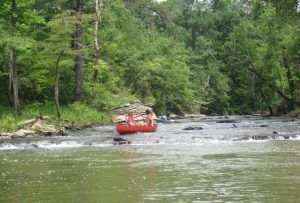The Shades Creek Watershed Management Plan is complete – Read it here.
Shades Creek is beautiful, yet has many challenges caused by urban runoff. The Nature Conservancy in Alabama (TNC) has taken leadership to develop a watershed plan to restore the Creek. One of the first meetings took place at the January 9, 2020 Friends of Shades Creek meeting at Homewood Library. Courtney Reich, AICP, CFM and Stormwater consultant with Goodwyn Mills Cawood (GMC) was the presenter for this program. Slides at that program can be viewed here.
The watershed plan follows EPA’s 9-step watershed management planning process and the work that TNC is facilitating in Shades Creek. This stakeholder-driven process provides a mechanism for citizens of the Shades Creek Watershed to identify water quality issues within the watershed and propose restoration solutions – such as green infrastructure retrofit projects and bank restoration – that would then become eligible for ADEM’s Section 319 (h) grant funding and other local and national sources.
What is The Shades Creek Watershed?
It’s the stream’s watershed which includes all of the land that, when rain falls, the rainwater flows into channels or streams making their way to the main stream – In this case, into Shades Creek. Go to this link to find the Shades Creek Watershed Management Plan Map:
https://wwwgmcplanning.com/ShadesCreek
At the above link, (Go to: Tell us what you think) you will find a short survey, where you can list assets and problems on Shades Creek and become part of the process of this Watershed Management Plan.
What is a Watershed Management Plan (WMP)?
A WMP is an essential first step in improving water quality in a watershed and mitigating the impacts of future develoment pressures. It provides documentation of existing environmental conditions and challenges while offering a vision and strategy for protecting the physical, chemical, and biological integrity for wildlife and human uses. The WMP will help us understand the condition of the watershed, to promote opportunities to ensure its long-term health, and to ensure that the public will be able to enjoy it for generations to come.
Ways Each of Us can Improve Our Watershed
When we each help on a small scale, we can have a major impact on our watershed. The EPA offers tips on how you can help keep your watershed clean and healthy:
Conserve water every day by taking shorter showers, fixing leaks and turn off the water when not in use. (such as when brushing your teeth)
Don’t pour toxic household chemicals down the drain. Take them to a hazardous waste center.
Don’t pour food fats and oils down the drain. Put into a receptacle that can be put in your trash.
Plant hardy plants in your yard, that require little or no watering, fertilizers or pesticides.
Recycle yard waste in a compost pile and use a mulching mower to reduce volume.
Use yard surfaces that allow rain to soak in and not run off.
Never pour used oil or antifreeze into the storm drain or the street.
Pick up after your pet, and dispose of the waste in the trash or toilet.
Drive less – walk or bike, many pollutants in our waters come from car exhaust and car leaks.
Benefits of a Healthy Watershed
Erosion/sedimentation control
Flood Control
Biological diversity
Soil formation
Wildlife movement corridors
Water storage
Water filtration
Carbon storage
Nutrient cycling
Food
Timber
Recreation
Reduced vulnerability to invasive species
Reduced effects of climate change and other natural disasters

